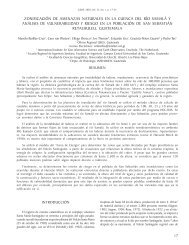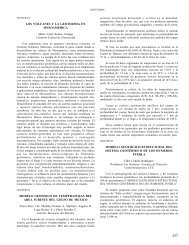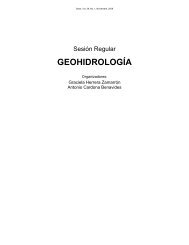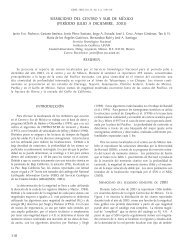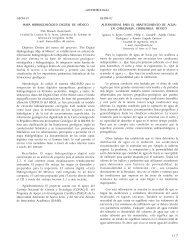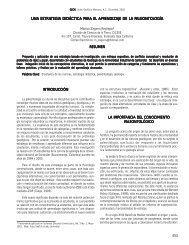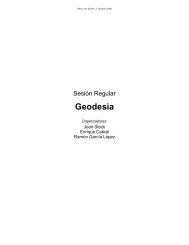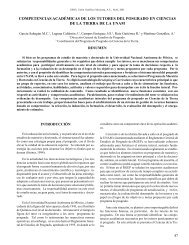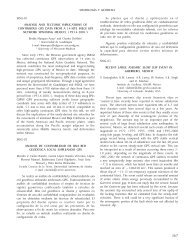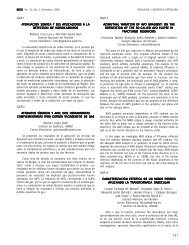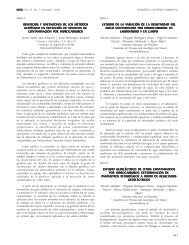Libro de resúmenes - Unión Geofisica Mexicana AC
Libro de resúmenes - Unión Geofisica Mexicana AC
Libro de resúmenes - Unión Geofisica Mexicana AC
Create successful ePaper yourself
Turn your PDF publications into a flip-book with our unique Google optimized e-Paper software.
Geos, Vol. 31, No. 1, Noviembre, 2011G-GAP (THE GUERRERO SEISMIC GAP): NEW INSIGHTS OF THE SEISMICCYCLE, EPISODIC ASEISMIC SLOW SLIPS AND NONVOLCANIC...stresses and normal values north of 160 km that <strong>de</strong>picts a combination of fluidpresence and high temperature.SE11-15ANALYSIS OF GREEN FUNCTIONS OBTAINED BYCROSS CORRELATIONS FOR MASE STATIONSVera Padilla Gabriela Berenice, Iglesias Mendoza Arturo,Legrand Denis, Cruz-Atienza Víctor M. y Singh Shri KrishnaInstituto <strong>de</strong> Geofísica, UNAMgberev@gmail.comWe used continuous records of broadband seismic stations of the MASEexperiment to obtain observed Green´s functions using the method of ambientnoise cross-correlations. The experiment consisted of 100 stations distributedalong a perpendicular line to the Mesoamerican trench across the Valley ofMexico.The stations recor<strong>de</strong>d continuously at 100 sps for more than two years. Thegeometry of the array provi<strong>de</strong> a good opportunity to study the attenuation effectsalong the coast-perpendicular structure.The method we used to compute Green functions involves a strong datapre-processing (temporal normalization and spectral whitening). However, ourresults show that the amplitu<strong>de</strong> of the cross-correlations still contains informationabout the surface waves attenuation and probably local amplification effects.Records from two regional earthquakes located close to Acapulco were used forcomparison.SE11-16OBSERVATIONS OF THE HYDRO<strong>AC</strong>OUSTIC T PHASEFROM THE GREAT 2010 CHILEAN EARTHQUAKEUSING DATA FROM G-GAP AND OTHER NETWORKSValenzuela Wong Raúl 1 , Kostoglodov Vladimir 1 , Husker Allen 1 , Payero DeJesús Juan Silvestre 2 , Shapiro Nikolai 3 , Campillo Michel 4 y Cotte Nathalie 41 Instituto <strong>de</strong> Geofísica, UNAM2 Instituto <strong>de</strong> Geofísica/Posgrado Ciencias <strong>de</strong> la Tierra, UNAM3 Institut <strong>de</strong> Physique du Globe <strong>de</strong> Paris, France4 Institut <strong>de</strong>s Sciences <strong>de</strong> la Terre, UJF, Franceraul@ollin.igeofcu.unam.mxThe French-Mexican Guerrero Seismic Gap (G-Gap) project was <strong>de</strong>signed tostudy slow slip events and nonvolcanic tremor in a region of the Middle AmericaTrench where no significant earthquakes have occurred in about one hundredyears. It inclu<strong>de</strong>s a total of 10 seismic mini-arrays which recor<strong>de</strong>d T wavesproduced by the February 27, 2010 Chilean earthquake (Mw = 8.8) at distancesof about 300 km from the 1000-m <strong>de</strong>pth contour (the acoustic-to-seismicconversion point) along the great circle path. This is significant given that Twaves are most often observed on island stations and stations very close tothe shoreline, or using hydrophones. Subhorizontal subduction of the slab inGuerrero may act as a wavegui<strong>de</strong> and probably explain the long distancesensitivity of inland stations to the T phase. Additionally we have used recordsfrom other continental stations provi<strong>de</strong>d by the Mexican Servicio SismológicoNacional (National Seismology Bureau) as well as stations on Socorro Island inthe Mexican Pacific, which the Bureau operates jointly with the ComprehensiveNuclear-Test-Ban Treaty Organization. Data were also obtained from the GlobalSeismographic Network (GSN) through the Incorporated Research Institutionsfor Seismology (IRIS) Data Management Center (DMC). We are currentlyanalyzing the effect of a long source time function (and rupture propagation) onthe observed T waveforms. We are also studying the polarization in or<strong>de</strong>r to<strong>de</strong>termine the direction the wave is coming from. Lastly, we are exploring thebathymetry along the 1000-m <strong>de</strong>pth contour to find the best acoustic-to-seismicconversion point.181



![Libro de resúmenes [revisión final, 172 páginas] - UGM](https://img.yumpu.com/51565067/1/190x245/libro-de-resamenes-revisian-final-172-paginas-ugm.jpg?quality=85)
